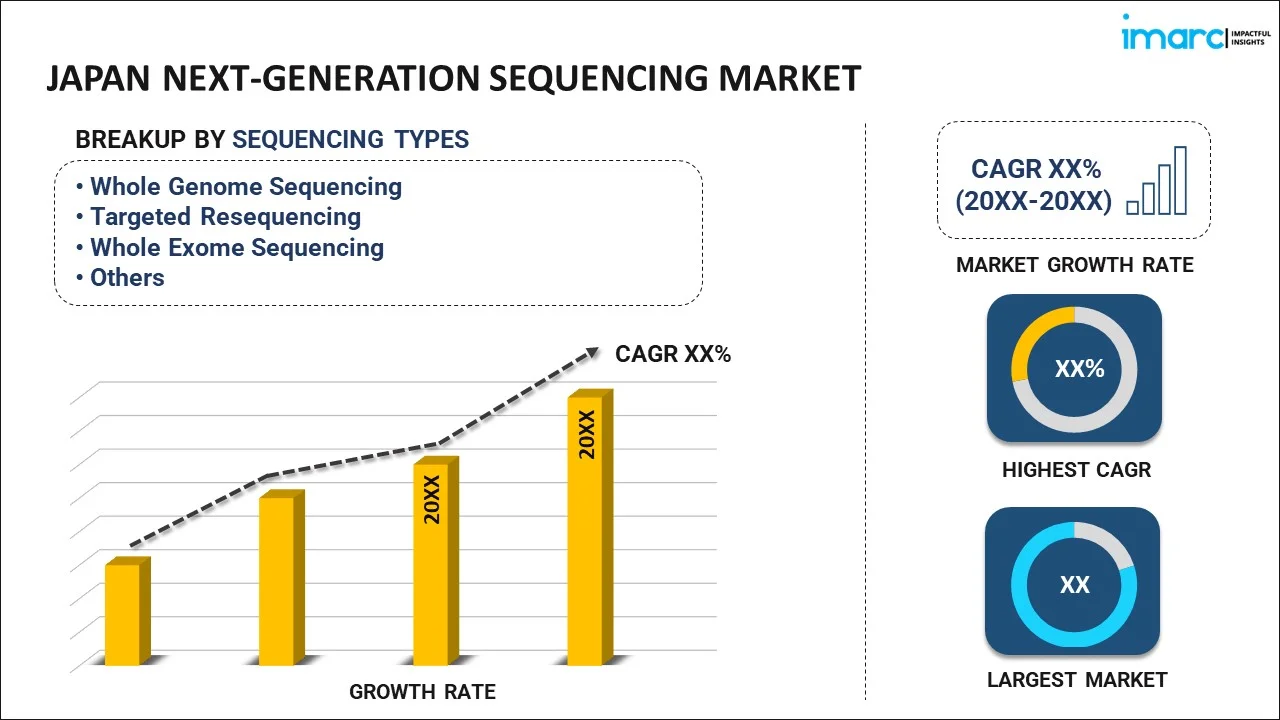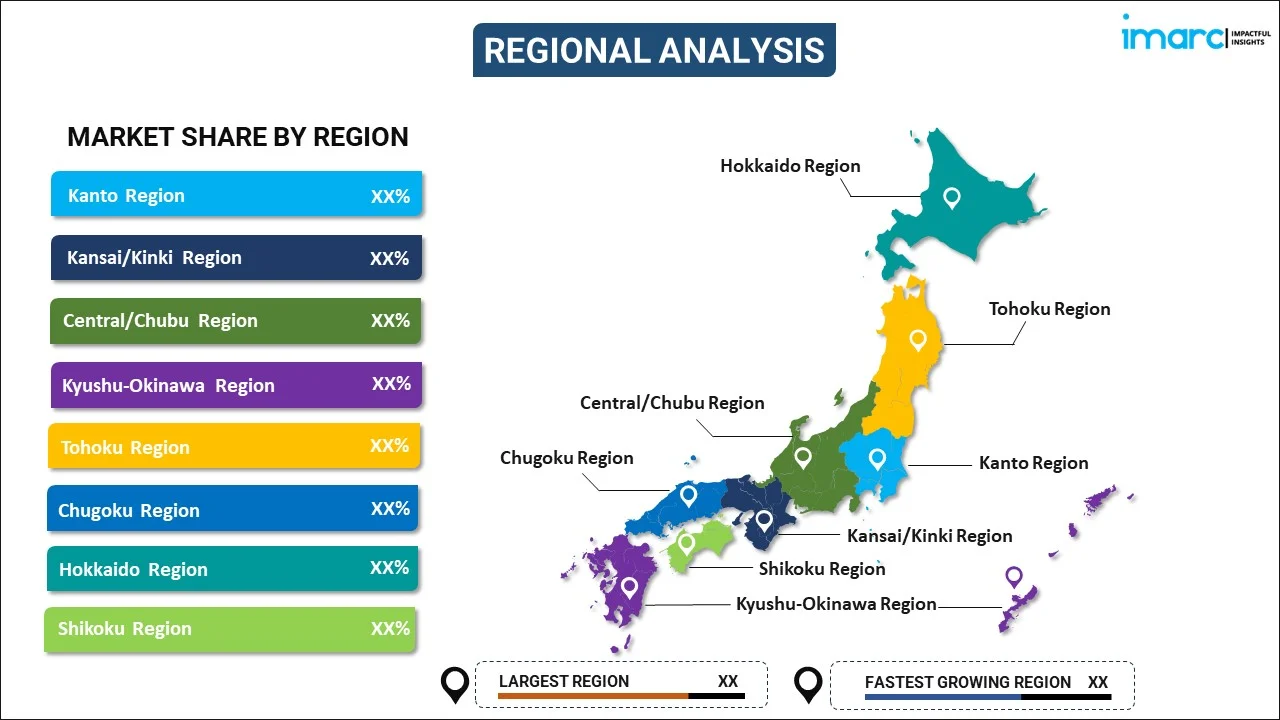
Japan Next-Generation Sequencing Market Report by Sequencing Type (Whole Genome Sequencing, Targeted Resequencing, Whole Exome Sequencing, RNA Sequencing, CHIP Sequencing, De Novo Sequencing, Methyl Sequencing, and Others), Product Type (Instruments, Reagents and Consumables, Software and Services), Technology (Sequencing by Synthesis, Ion Semiconductor Sequencing, Single-Molecule Real-Time Sequencing, Nanopore Sequencing, and Others), Application (Biomarker and Cancer, Drug Discovery and Personalized Medicine, Genetic Screening, Diagnostics, Agriculture and Animal Research, and Others), End User (Academic Institutes and Research Centers, Hospitals and Clinics, Pharmaceutical and Biotechnology Companies, and Others), and Region 2025-2033
Market Overview:
Japan next-generation sequencing market size reached USD 1.1 Billion in 2024. Looking forward, IMARC Group expects the market to reach USD 7.9 Billion by 2033, exhibiting a growth rate (CAGR) of 22.4% during 2025-2033. The escalating incidence of chronic diseases, such as cancer and genetic disorders, which has increased the demand for advanced genetic testing and sequencing technologies, is driving the market.
|
Report Attribute
|
Key Statistics
|
|---|---|
|
Base Year
|
2024 |
|
Forecast Years
|
2025-2033
|
|
Historical Years
|
2019-2024
|
| Market Size in 2024 | USD 1.1 Billion |
| Market Forecast in 2033 | USD 7.9 Billion |
| Market Growth Rate (2025-2033) | 22.4% |
Next-generation sequencing (NGS) is a high-throughput, massively parallel DNA sequencing technology that enables the rapid and cost-effective analysis of entire genomes, transcriptomes, and epigenomes. NGS simultaneously sequences millions of DNA fragments, allowing for the generation of large volumes of data in a single run. This technology has revolutionized genomics research and biomedical applications by facilitating the study of genetic variations, gene expression patterns, and the identification of disease-causing mutations. NGS has diverse applications, including whole-genome sequencing, exome sequencing, RNA sequencing, and ChIP sequencing, among others. It has significantly accelerated the pace of biological and medical research, contributing to advances in personalized medicine, disease diagnosis, and the understanding of complex biological processes. However, challenges such as data analysis, storage, and interpretation remain, requiring the development of robust bioinformatics tools and computational techniques to fully harness the potential of NGS in various scientific fields.
Japan Next-Generation Sequencing Market Trends:
The next-generation sequencing market in Japan is experiencing rapid growth, largely fueled by several key factors. Firstly, the increasing prevalence of chronic diseases regionally has heightened the demand for advanced diagnostic tools, propelling the adoption of NGS technologies. Consequently, healthcare providers are increasingly integrating NGS into their clinical practices, aiming to offer personalized treatments and enhance patient outcomes. Moreover, the plummeting costs associated with genome sequencing have significantly broadened the accessibility of NGS platforms, thereby encouraging their widespread utilization across research and clinical settings. Additionally, the escalating focus on precision medicine and the rising significance of genomics in drug discovery and development has bolstered the demand for NGS, fostering collaborations between biotechnology firms and research institutions to expedite the translation of genomic insights into targeted therapies. Furthermore, the continual advancements in bioinformatics tools and data analysis techniques, which have facilitated the interpretation of complex genomic data, thereby stimulating the adoption of NGS technologies in various fields, are expected to drive the NGS market in Japan during the forecast period.
Japan Next-Generation Sequencing Market Segmentation:
IMARC Group provides an analysis of the key trends in each segment of the market, along with forecasts at the country level for 2025-2033. Our report has categorized the market based on sequencing type, product type, technology, application, and end user.
Sequencing Type Insights:

- Whole Genome Sequencing
- Targeted Resequencing
- Whole Exome Sequencing
- RNA Sequencing
- CHIP Sequencing
- De Novo Sequencing
- Methyl Sequencing
- Others
The report has provided a detailed breakup and analysis of the market based on the sequencing type. This includes whole genome sequencing, targeted resequencing, whole exome sequencing, RNA sequencing, chip sequencing, de novo sequencing, methyl sequencing, and others.
Product Type Insights:
- Instruments
- Reagents and Consumables
- Software and Services
A detailed breakup and analysis of the market based on the product type have also been provided in the report. This includes instruments, reagents and consumables, and software and services.
Technology Insights:
- Sequencing by Synthesis
- Ion Semiconductor Sequencing
- Single-Molecule Real-Time Sequencing
- Nanopore Sequencing
- Others
The report has provided a detailed breakup and analysis of the market based on the technology. This includes sequencing by synthesis, ion semiconductor sequencing, single-molecule real-time sequencing, nanopore sequencing, and others.
Application Insights:
- Biomarker and Cancer
- Drug Discovery and Personalized Medicine
- Genetic Screening
- Diagnostics
- Agriculture and Animal Research
- Others
A detailed breakup and analysis of the market based on the application have also been provided in the report. This includes biomarker and cancer, drug discovery and personalized medicine, genetic screening, diagnostics, agriculture and animal research, and others.
End User Insights:
- Academic Institutes and Research Centers
- Hospitals and Clinics
- Pharmaceutical and Biotechnology Companies
- Others
The report has provided a detailed breakup and analysis of the market based on the end user. This includes academic institutes and research centers, hospitals and clinics, pharmaceutical and biotechnology companies, and others.
Regional Insights:

- Kanto Region
- Kansai/Kinki Region
- Central/ Chubu Region
- Kyushu-Okinawa Region
- Tohoku Region
- Chugoku Region
- Hokkaido Region
- Shikoku Region
The report has also provided a comprehensive analysis of all the major regional markets, which include Kanto Region, Kansai/Kinki Region, Central/ Chubu Region, Kyushu-Okinawa Region, Tohoku Region, Chugoku Region, Hokkaido Region, and Shikoku Region.
Competitive Landscape:
The market research report has also provided a comprehensive analysis of the competitive landscape. Competitive analysis such as market structure, key player positioning, top winning strategies, competitive dashboard, and company evaluation quadrant has been covered in the report. Also, detailed profiles of all major companies have been provided.
Japan Next-Generation Sequencing Market Report Coverage:
| Report Features | Details |
|---|---|
| Base Year of the Analysis | 2024 |
| Historical Period | 2019-2024 |
| Forecast Period | 2025-2033 |
| Units | Billion USD |
| Scope of the Report | Exploration of Historical Trends and Market Outlook, Industry Catalysts and Challenges, Segment-Wise Historical and Future Market Assessment:
|
| Sequencing Types Covered | Whole Genome Sequencing, Targeted Resequencing, Whole Exome Sequencing, RNA Sequencing, CHIP Sequencing, De Novo Sequencing, Methyl Sequencing, Others |
| Product Types Covered | Instruments, Reagents and Consumables, Software and Services |
| Technologies Covered | Sequencing by Synthesis, Ion Semiconductor Sequencing, Single-Molecule Real-Time Sequencing, Nanopore Sequencing, Others |
| Applications Covered | Biomarker and Cancer, Drug Discovery and Personalized Medicine, Genetic Screening, Diagnostics, Agriculture and Animal Research, Others |
| End Users Covered | Academic Institutes and Research Centers, Hospitals and Clinics, Pharmaceutical and Biotechnology Companies, Others |
| Regions Covered | Kanto Region, Kansai/Kinki Region, Central/ Chubu Region, Kyushu-Okinawa Region, Tohoku Region, Chugoku Region, Hokkaido Region, Shikoku Region |
| Customization Scope | 10% Free Customization |
| Post-Sale Analyst Support | 10-12 Weeks |
| Delivery Format | PDF and Excel through Email (We can also provide the editable version of the report in PPT/Word format on special request) |
Key Questions Answered in This Report:
- How has the Japan next-generation sequencing market performed so far and how will it perform in the coming years?
- What has been the impact of COVID-19 on the Japan next-generation sequencing market?
- What is the breakup of the Japan next-generation sequencing market on the basis of sequencing type?
- What is the breakup of the Japan next-generation sequencing market on the basis of product type?
- What is the breakup of the Japan next-generation sequencing market on the basis of technology?
- What is the breakup of the Japan next-generation sequencing market on the basis of application?
- What is the breakup of the Japan next-generation sequencing market on the basis of end user?
- What are the various stages in the value chain of the Japan next-generation sequencing market?
- What are the key driving factors and challenges in the Japan next-generation sequencing?
- What is the structure of the Japan next-generation sequencing market and who are the key players?
- What is the degree of competition in the Japan next-generation sequencing market?
Key Benefits for Stakeholders:
- IMARC’s industry report offers a comprehensive quantitative analysis of various market segments, historical and current market trends, market forecasts, and dynamics of the Japan next-generation sequencing market from 2019-2033.
- The research report provides the latest information on the market drivers, challenges, and opportunities in the Japan next-generation sequencing market.
- Porter's five forces analysis assist stakeholders in assessing the impact of new entrants, competitive rivalry, supplier power, buyer power, and the threat of substitution. It helps stakeholders to analyze the level of competition within the Japan next-generation sequencing industry and its attractiveness.
- Competitive landscape allows stakeholders to understand their competitive environment and provides an insight into the current positions of key players in the market.
Need more help?
- Speak to our experienced analysts for insights on the current market scenarios.
- Include additional segments and countries to customize the report as per your requirement.
- Gain an unparalleled competitive advantage in your domain by understanding how to utilize the report and positively impacting your operations and revenue.
- For further assistance, please connect with our analysts.
 Inquire Before Buying
Inquire Before Buying
 Speak to an Analyst
Speak to an Analyst
 Request Brochure
Request Brochure
 Request Customization
Request Customization




.webp)




.webp)












